
This parent guide supports parents in helping their child at home with the 8th grade Science content.
- Subject:
- Science
- Material Type:
- Reference Material
- Vocabulary
- Author:
- Kelly Rawlston
- Letoria Lewis
- Date Added:
- 10/11/2022

This parent guide supports parents in helping their child at home with the 8th grade Science content.

This resource accompanies our Rethink 8th Grade Science course. It includes ideas for use, ways to support exceptional children, ways to extend learning, digital resources and tools, tips for supporting English Language Learners and students with visual and hearing impairments. There are also ideas for offline learning.

In this lesson, students will differentiate matter into pure substances (elements and compounds) and mixtures on a basic molecular level. Students will use hands-on card sorting to create a rule for sorting matter. The definitions of pure substance, mixture, element, and compound will be introduced.
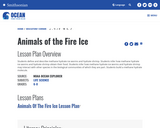
Students learn about methane hydrate ice worms and hydrate shrimp, including how they obtain their food and interact with other species in deep sea ecosystems. Students will work in collaborative groups to research these organisms to develop hypotheses about the relationship between methane hydrates, ice worms, and hydrate shrimp and present their hypotheses to the class. In an extension activity, students will construct models of methane hydrate molecules.

With this resource, students will play 20 questions using the periodic table and a list of common molecules.

With this resource, students will use what they know about atoms and molecules to decide whether an example is an atom or a molecule.
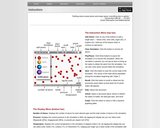
This app for iPad devices is a fully interactive atomistic simulation that shows the motions of atoms as they attract, repel, and collide with one another. With the tap or swipe of a finger, students can add, delete, or highlight molecules, as well as increase/decrease temperature, pressure, or volume and explore the states of matter. An associated simulation, Salts, allows students to manipulate atoms and ions to join to form crystals.

CK-12 Physical Science Concepts covers the study of physical science for middle school students. The 5 chapters provide an introduction to physical science, matter, states of matter, chemical interactions and bonds, chemical reactions, motion and forces, and the types and characteristics of energy.

Using this resource, students will sort materials based on properties.

In this lesson, students learn about homogenous and heterogeneous mixtures. They will then devise a way to separate a heterogeneous mixture of salt, black pepper, and sand using the equipment available to them. This lesson begins on p. 24 of the pdf document.
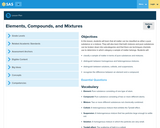
In this lesson, students will learn that all matter can be classified as either a pure substance or a mixture. They will also learn that both mixtures and pure substances can be broken down into subcategories and that there are techniques chemists use to determine in which category a sample of matter belongs.
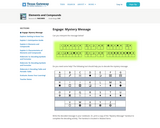
In this lesson, students differentiate between elements and compounds by learning about the basic characteristics of elements and compounds.

In this lesson, students will learn that sunlight is the underlying component of energy use. Students will examine atoms as the basic building blocks of matter, including electrons, protons, and neutrons, and explore how these building blocks are used with the element silicon (Si) to produce energy. Students will perform two interactive activities to further their understanding of this concept. Finally, students will investigate careers in solar energy and report on the growing solar industry.

This resource supports English language development for English Language Learners. Students will study various aspects of atomic theory and elements and incorporate language objectives in this SIOP unit. The resource includes targeted vocabulary, student worksheets, and activities across all language domains.

In this lesson, students use chemical formulas for common compounds to experiment with how atoms come together to make molecules and compounds with unique properties and characteristics.
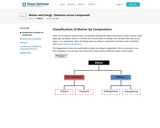
This resource is a compilation of text, videos, and other elements that serves as a multimedia learning experience for students. The resource reviews how matter can be classified by its composition.

Students examine a variety of materials and classify them as mixtures or solutions.
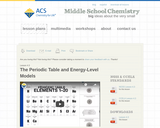
Students will focus on the first 20 elements. Students will first look at a diagram and animation to understand the basic pattern of the arrangement of electrons on energy levels around an atom. Students can be given cards with information about the electrons and energy levels for each of the first 20 atoms. They can try to correctly match the cards with the element. This lesson includes, with direct links to, a student activity sheet, an image of an energy level cross section, an image of an oxygen atom, an image of a periodic table of energy levels, videos on sodium in water, potassium in water and calcium in water as well as sodium, potassium and calcium in acid, an answer key for the student activity sheet and a teacher background section on energy level models.

This chapter from the online textbook Everything Science discusses classification of matter and outlines the differences between elements, compounds, and mixtures. Each chapter comes with video lessons and explanations which help bring the ideas and concepts to life.

Students are introduced to molecules, atoms, chemical notation, and chemical compounds through an engaging hands-on wet lab and LEGO brick models of atoms. Students will conduct a chemical reaction, compare physical and chemical changes, and then explore how matter is conserved during the reaction.